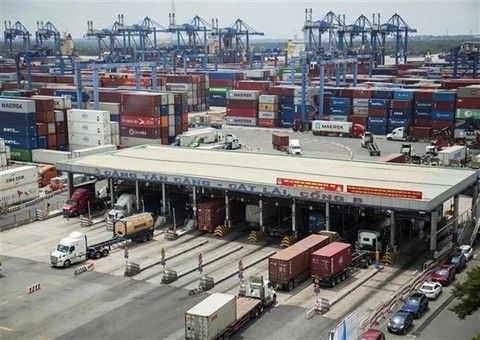
A view of the Tân Cảng Cát Lái Port in HCM City. A view of the Tân Cảng Cát Lái Port in HCM City. — VNA/VNS Photo Hồng Đạt
Businesses must start taking measures to protect themselves from highly volatile exchange rate fluctuations, approaching the VNĐ25,000/US$1 mark since the beginning of the year, said economists and business experts.
Economist Đinh Trọng Thịnh said the increase in the exchange rate is due to a rise in demand for foreign currency, which is needed for increased import-export activities in the first quarter of the year. In addition, the global market has seen a surge in gold prices, sending people to seek refuge in the US dollar, which has sent rates to over VNĐ25,700/$1, significantly higher than those offered by commercial banks.
Thân Đức Việt, CEO of Garment Corporation 10, one of Việt Nam's largest textile companies, said while higher exchange rates benefit the corporation's revenue, they have to pay more to import equipment, machinery and raw materials. He said that sharp fluctuations in foreign exchange rates will exert increased pressure on the country's import-export activities and the stability of the VNĐ.
Nguyễn Văn Kết, director of SKD Vietnam Mechanical Company, said strong fluctuations in the exchange rate were expected during the beginning months of the year. As the appreciation of the US dollar negatively impacts businesses that rely heavily on the greenback for imports or loans, leading to increased costs. However, he said that a 2-3 per cent devaluation of the VNĐ is within acceptable range.
As exchange rate fluctuations raise import costs for businesses that trade in the US dollar, they also tend to benefit from the revenue in VNĐ of export-oriented businesses. Financial expert Nguyễn Trí Hiếu said, however, a prolonged period of depreciation of the VNĐ against the US dollar may harm export activities and risk importing inflation, as Vietnamese producers, both for export and domestic consumption, are heavily dependent on imported input materials and this would likely hurt their bottom lines in the long run.
He said the State Bank of Vietnam (SBV) has shown in the past that it has sufficient tools and expertise to intervene to ensure stability in the exchange rate. Recently, the central bank has started an increment of treasury bills to help alleviate pressure on the exchange rate, import-export stability and production. While the risk of major downturns remains low, businesses must make it a habit to be more proactive in planning their payment currencies and diversifying their import-export markets to reduce reliance on the US dollar. He said forecasts by experts and international organisations see the USD/VNĐ exchange rate cooling down to VNĐ23,600 in the third quarter of this year and VNĐ23,500 by the fourth.
Lê Quốc Phương, former deputy director of the Industrial and Commercial Information Centre under the Ministry of Industry and Trade, said businesses need better forecasting models and risk prevention tools related to exchange rates. For example, using financial derivatives and diversifying payment currencies may help minimise risks and even bring benefit from currency fluctuations.
In its reports, the State Bank of Vietnam has consistently emphasised its flexible exchange rate management, which is appropriate to domestic and international situations, helping absorb external shocks, stabilise the foreign exchange market, and limit short-term exchange rate fluctuations, thus maintaining currency value stability and ensuring smooth liquidity, fully meeting lawful foreign currency demands.
The central bank has been consistent in a flexible approach to managing the exchange rate while maintaining stability, liquidity and legal international commitments. While the informal exchange rate appears higher than its official counterpart, its trading volume remains a fraction in comparison to Việt Nam's overall forex market activity, as almost all transactions by individuals and entities are serviced through banks. — VNS